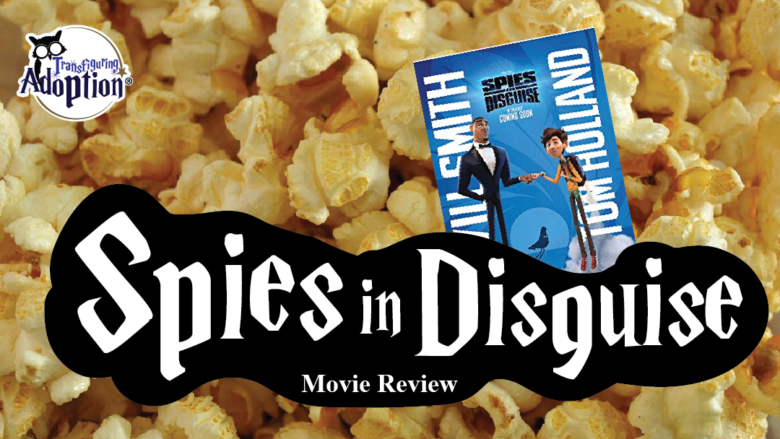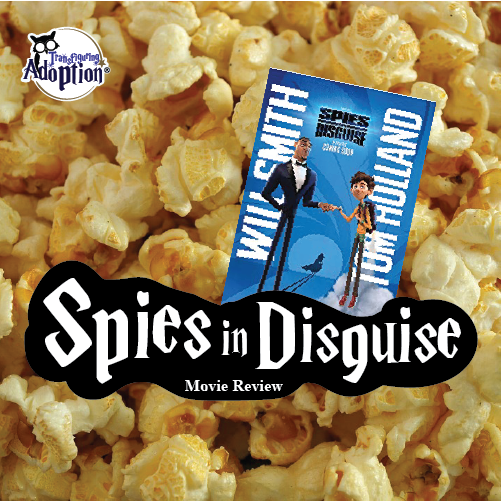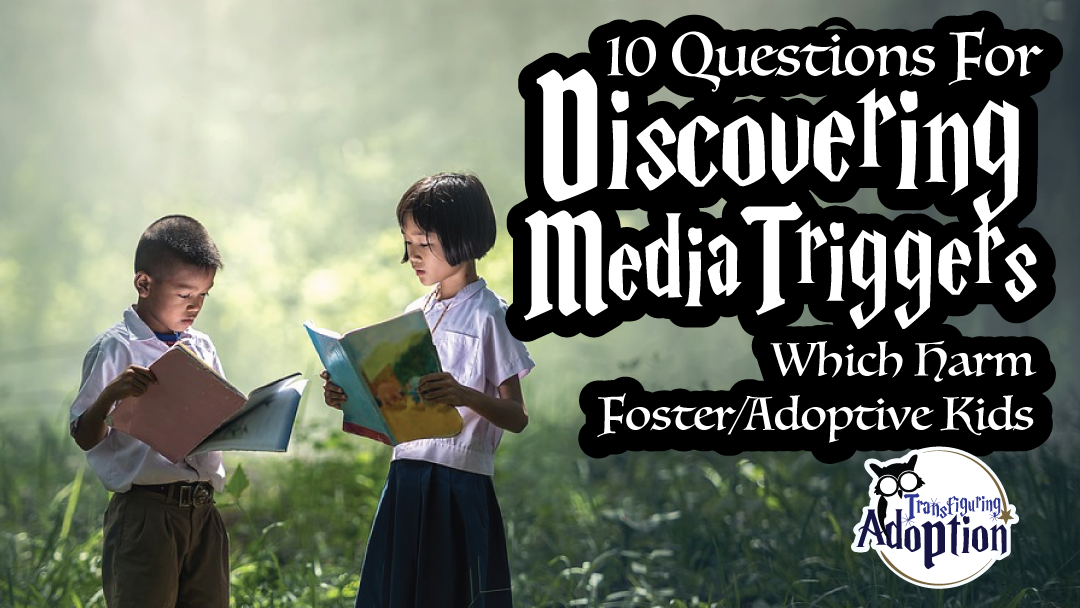Grade:
Transfiguring Adoption awarded this movie 3 Hoots out of 5 based on how useful it will be for a foster/adoptive family. [Learn more about our Hoot grading system here]
Movie Info:
From the Cover of Spies in Disguise by 20th Century Fox:
“Super spy Lance Sterling (Will Smith) and scientist Walter Beckett (Tom Holland) are almost exact opposites. Lance is smooth, suave and debonair. Walter is…not. But when events take an unexpected turn, this unlikely duo is forced to team up for the ultimate mission that will require an almost impossible disguise – transforming Lance into the brave, fierce, majestic…pigeon. Walter and Lance suddenly have to work as a team, or the whole world is in peril.”
“Spies in Disguise” is a fun, animated action movie. The story pairs super-spy Lance Sterling (voiced by Will Smith) and young, quirky inventor Walter (voiced by Spider Man’s Tom Holland) in a buddy-cop style adventure to save the world, with the added difficulty of Lance being turned into a pigeon in an experiment gone wrong. Along the way they learn the value of teamwork and accepting help and show the world that there are ways to deal with problems without resorting to violence. For James Bond fans, there are also several homages and parodical references to those movies throughout this film which are a fun addition.
This movie would be suitable primarily for older kids and preteens (9-14) as there is a fairly extensive amount of violence that would likely be troubling for younger children, as well as some nudity and ‘bathroom humor’ that edges into being inappropriate at times.
** Spoilers Could Be Ahead **
How Is This Relevant To Adoption & Foster Care?
The movie opens with a scene of Walter and his mom, where we see Walter’s desire to protect her and also make her proud. We later learn that his mom dies and as a young adult, Walter struggles to lead a life that would make her proud. However, he is often looked down upon for being ‘weird’ and different. These are all feelings that youth in care often struggle with: dealing with the loss of a parent (even if that parent is still alive, they aren’t with them), wanting that parent to be proud of them, having other people think they are strange because of their differences.
Throughout the movie, Lance Sterling, who is shown as a hero, claims that he doesn’t need anyone and prefers to ‘fly solo’. His sidekick, Walter, tried to prove to him that things are better in a ‘flock’ and helps him learn to accept help from his new friends. This is something a lot of foster and adoptive kids can relate to. Because of their circumstances and past experiences, they may feel like they have had to survive on their own and either don’t need help, or don’t trust those around them to have their best interests at heart. Lance learns to accept the help of his friends and that a ‘flock’ doesn’t leave anyone behind. This can be a helpful theme for children in care as they are often learning how to be part of a functional family system and building trusting relationships.
Discussion Points:
- Importance of Friendship/Teamwork:
Lance Sterling is the best-of-the-best super spy and everyone reveres him as a hero. In the opening sequence we see him defeat an entire room of bad guys basically alone. When he meets Walter, who offers help, Lance states that he prefers to ‘fly solo’. However, when Lance gets turned into a pigeon, he learns that he sometimes needs to rely on others and how being part of a ‘flock’ or team can be a good thing. This can be a good opportunity to talk to youth about the benefits of being able to rely on others and work as part of a team. - Non-Violent Problem Solving:
Walter is a quirky sidekick who loves to invent new spy gadgets. However, his gadgets are unique in that they are not weapons and instead find unusual ways to solve problems with more friendly means, such as glitter or kittens. He claims that, “You can do more by bringing people together than blowing them up,” and that “there’s a better way”. In today’s world children are bombarded by images and stories of violence and it’s used to solve problems. This can be especially true in children from abusive homes or those who lived in areas with high community violence. Being able to see a hero take down bad guys without resorting to violence of his own shows that there are alternative ways to solve their problems. - Being True to Yourself:
When Walter is young he worries that other kids don’t like him and that he’s too weird. His mom tells him that “the world needs more weird”. This is a theme that comes into play throughout the movie and Walter’s ‘weird’ ideas are often what helps his team succeed. This can be a good opportunity to discuss with children the things that make them unique and how sometimes the things about themselves that they think are ‘weird’ or ‘strange’ are actually some of their strengths. While Walter sometimes worries about how others think about him, he never changes to make them like him better. He always stays true to who he is, which makes him a great role model.
Cautionary Points:
- Death of a Parent:
We learn early on that Walter’s mother (who seemed to be a single parent) has died and he is pretty much alone now. The death occurs off-screen and is not directly discussed, but the emotional impact this has had on Walter and his decisions is definitely portrayed and may be difficult for children who have recently experienced a parental loss. - Violence/Peril:
The movie has an overarching theme of there being ‘a better way’ than violence to solve problems, and in the end the good guys win by using Walter’s inventions that have quirky, but effective alternatives to violence. However, it takes until the end of the movie for the main character, Lance, to value this approach and until we get there, there are frequent action scenes where the heroes must defeat groups of villains and there are a lot of guns and other weapons used frequently throughout the movie. Our heroes are also often in danger and there are times where it seems like one or more of the characters aren’t going to make it, which can be stressful to young viewers. - Nudity/Bathroom Humor:
There is one scene in particular where you see a male villain’s rear end pretty extensively, though it is not shown in a sexual context and is intended to be humorous. Also, after Lance is turned into a pigeon (a female pigeon, no less), his anatomy as related to using the bathroom is used frequently as a running joke. - Inappropriate Touching:
There is one scene where the villain’s finger gets shoved inside the private area of a pigeon. The scene is brief, and the act is not done in an intentional or sexual way, rather it’s intended for laughs. It will likely go over the head of most kids. However, for children who have been victims of sexual abuse, the scene may be upsetting.
Discussion Guide:
- Which character did you relate to the most? Are you more like Walter or Lance?
[CAREGIVER NOTE: This question is primarily useful for bonding and starting a conversation about the movie with a low-risk topic. However, the child’s response may give some valuable information about how they view themselves. Lance is more of a classic ‘strong hero’ character, but is solitary and tends to prefer to work alone. Walter is weird/quirky and has lost his parents, however he values his friends and trying to make the world a better place.]
- Walter calls Lovey, his pigeon, his ‘emotional support animal’. What is their relationship like? How does Lovey help Walter?
[CAREGIVER NOTE: Walter has lost his mother and as far as we know his father is not in the picture. He doesn’t seem to have many friends due to others feeling that he is ‘weird’. However, Walter has a pet pigeon named Lovey whom he is extremely devoted to. He learns all he can about pigeons so he can take the best possible care of her. In return, Lovey provides companionship to Walter and helps him feel less lonely. When Walter learns that Lance can understand what the other pigeons are saying he is eager to know if Lovey is happy. Talking about this relationship can help children think about the importance and benefits of building their own relationships with others whether they be a pet, a friend, or a family member.]
- Early in the movie Lance claims that he doesn’t need any help and that he ‘flies solo’. However, Walter continually tries to show him that things go better when he’s part of a ‘flock’. What are some examples in the movie where Lance benefited from having friends and a ‘flock’ to help him?
[CAREGIVER NOTE: Notable examples include when Lance is trying to sneak into the villain’s hotel room and is struggling to get the key card, his fellow flock of pigeons helps out and with their teamwork they are able to succeed. Another time is at the end of the movie when they are defeating the villains it takes Lance’s physical skills but also Walter’s unusual inventions for the spy team to succeed.]
- Have there been times in your life where you benefited from being part of a group and having people to help you? Have there ever been times when you didn’t have help and wish you had?
[CAREGIVER NOTE: This question can vary in answers. Some children may not have had experiences of being in a team or positive group environment before, so they may not be able to answer the first question. For these children it may be more helpful to talk about the second part and think about situations that did not work out the way they wanted them to and think about how having a family/flock/team might have provided a different outcome.]
- Lance gets turned into a pigeon and ends up stuck that way for much of the movie and has to adapt and learn a new way of doing things. What do you think it would be like to get turned into an animal? If you could choose any animal to be turned into, what would you chose?
[CAREGIVER NOTE: This is a fun way for children to think about what it would be like to be someone or something else. Younger children will likely pick an animal simply because they like it. But older children might be able to think more in-depth about what skills different animals have and choose an animal based on traits they wish they had (strong, fast, able to blend in, etc.). For further discussion ask the child about why they picked the animal, and if the animal is able to do things they can’t and why they wish they could (i.e. they would turn into a cheetah because they are extremely fast and could fun away from bad people).]
- Walter likes to make inventions that solve problems without resorting to violence (such as his glitter bomb, and cat picture distractions). Which of Walter’s inventions was your favorite?
[CAREGIVER NOTE: This question is primarily for bonding, and as a lead in to the next few questions. But it could also provide an opportunity to talk about Walter’s insistence that there are better ways to handle things and that violence isn’t the answer, which is demonstrated by his creative gadgets.]
- What invention would you make if you were Walter? What problem would it solve?
[CAREGIVER NOTE: Help children brainstorm what kinds of problems they wish they could fix. This can provide insight into what they struggle with and what things about their life or the world that they wish they could change. It can also be very empowering to invent a gadget or machine that would be able to fix that problem. While these fictional gadgets aren’t a real solution, they can get kids brainstorming and talking about the problem and may help them eventually figure out an actual solution they can try to work towards.]
- ACTIVITY: Create an invention prototype!
[CAREGIVER NOTE: This takes the previous discussion one step further and may help make their inventions feel more tangible. This can be as simple as drawing a picture or blueprint of your inventions, depending on child’s skill level. Or if you want to take it one step further, you could use household items like cardboard, paper, tape, etc. to build a more tangible prototype, like the cardboard watch Walter makes for his mom at the beginning of the movie.]
- Walter struggles as a child because he feels like everyone thinks he’s weird and his mom tells him ‘the world needs more weird’. What do you think she means by this?
[CAREGIVER NOTE: Walter’s mother loves him just the way he is and celebrates his uniqueness. Because of this Walter develops into a young adult who is confident in who he is, even if others don’t understand or like it. The world would be a boring place if everyone were exactly the same, and it’s important to celebrate our differences and the things that make us unique. This can be difficult for children with a background of trauma because they often had less supportive environments than Walter’s and may have lower self-confidence because of this. They also are more likely to already feel different and weird because of their situation and therefore strive to fit-in and be normal even more.]
- How did Walter’s ‘weirdness’ or differences help him defeat the bad guys?
[CAREGIVER NOTE: This builds off the last question and can help kids think about how Walter’s ‘weirdness’ was often what saved the day throughout the movie. Help them identify some of their own unique traits and think about ways that these differences might be used as strengths.]
About the Author: Jenn Ehlers
Jenn is a central Virginia native who received her BA in Psychology from the University of Virginia in 2012. Since then she has worked for a local mental health agency and the Department of Social Services in various capacities and has been involved in her community’s efforts to create a Trauma Informed Network. Currently Jenn works in vocational rehab and mentors youth in foster care. When she isn’t working, Jenn enjoys writing stories, anything and everything Harry Potter, and spending time with her niece and nephew.
**Transfiguring Adoption is a nonprofit organization seeking to nurture growth in foster and adoptive families by giving a HOOT about their families. Transfiguring Adoption does not intend for its reviewers nor its review to be professional, medical or legal advice. These reviews and discussion guides are intended to help parents to better be able to connect and understand their children who come from traumatic backgrounds.


